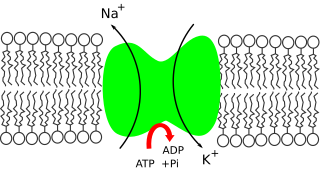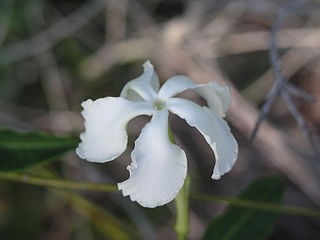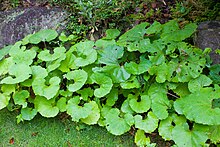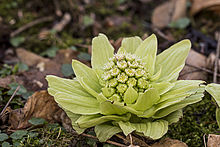
Potassium is the main intracellular ion for all types of cells, while having a major role in maintenance of fluid and electrolyte balance. Potassium is necessary for the function of all living cells, and is thus present in all plant and animal tissues. It is found in especially high concentrations within plant cells, and in a mixed diet, it is most highly concentrated in fruits. The high concentration of potassium in plants, associated with comparatively very low amounts of sodium there, historically resulted in potassium first being isolated from the ashes of plants (potash), which in turn gave the element its modern name. The high concentration of potassium in plants means that heavy crop production rapidly depletes soils of potassium, and agricultural fertilizers consume 93% of the potassium chemical production of the modern world economy.

Petasites is a genus of flowering plants in the sunflower family, Asteraceae, that are commonly referred to as butterburs and coltsfoots. They are perennial plants with thick, creeping underground rhizomes and large rhubarb-like leaves during the growing season. Most species are native to Asia or southern Europe.

Dutch processed cocoa, Dutch cocoa, or alkalized cocoa, is cocoa solids that have been treated with an alkalizing agent to reduce the natural acidity of cocoa, giving it a less bitter taste compared to "natural cocoa" extracted with the Broma process. It forms the basis for much of modern chocolate, and is used in ice cream, hot chocolate, and baking.

Tussilago farfara, commonly known as coltsfoot, is a plant in the tribe Senecioneae in the family Asteraceae, native to Europe and parts of western and central Asia. The name "tussilago" is derived from the Latin tussis, meaning cough, and ago, meaning to cast or to act on. It has had uses in traditional medicine, but the discovery of toxic pyrrolizidine alkaloids in the plant has resulted in liver health concerns.

Petasites frigidus, the Arctic sweet coltsfoot or Arctic butterbur, is a species of flowering plant in the family Asteraceae. It is native to Arctic to cool temperate regions of the Northern Hemisphere in northern Europe, northern Asia and northern North America.

Petasites hybridus, also known as the butterbur, is a herbaceous perennial flowering plant in the family Asteraceae that is native to Europe and northern Asia.

Guaraná Antarctica is a guaraná-flavoured soft drink, originating in Brazil. It was created in 1921 by Pedro Baptista de Andrade for Companhia Antarctica Paulista. The drink is produced in five countries: Portugal, Brazil, Argentina, Bolivia and Japan.

Arctium lappa, commonly called greater burdock, gobō (牛蒡/ゴボウ), edible burdock, lappa, beggar's buttons, thorny burr, or happy major is a Eurasian species of plants in the family Asteraceae, cultivated in gardens for its root used as a vegetable. It has become an invasive weed of high-nitrogen soils in North America, Australia, and other regions.
The vitamin E family comprises four tocotrienols and four tocopherols. The critical chemical structural difference between tocotrienols and tocopherols is that tocotrienols have unsaturated isoprenoid side chains with three carbon-carbon double bonds versus saturated side chains for tocopherols.

Glebionis coronaria, formerly called Chrysanthemum coronarium, is a species of flowering plant in the family Asteraceae. It is native to the Mediterranean region. It is cultivated and naturalized in East Asia and in scattered locations in North America.

Ageratum conyzoides is native to Tropical America, especially Brazil, and is an invasive weed in many other regions. It is an herb that is 0.5–1 m. high, with ovate leaves 2–6 cm long, and flowers are white to mauve.

Dry cocoa solids are the components of cocoa beans remaining after cocoa butter, the fatty component of the bean, is extracted from chocolate liquor, roasted cocoa beans that have been ground into a liquid state. Cocoa butter is 46% to 57% of the weight of cocoa beans and gives chocolate its characteristic melting properties. Cocoa powder is the powdered form of the dry solids with a small remaining amount of cocoa butter. Untreated cocoa powder is bitter and acidic. Dutch process cocoa has been treated with an alkali to neutralize the acid.

Farfugium japonicum is a species of flowering plant in the family Asteraceae, also known as leopard plant, green leopard plant or tractor seat plant. It is native to streams and seashores of Japan, where it is called tsuwabuki (石蕗).
Isostar is a sports drink sold in Europe. It is similar to Gatorade and Powerade in that it hydrates and provides energy through glucose. Isostar was first created in Switzerland in 1977.

Fisetin (7,3′,4′-flavon-3-ol) is a plant flavonol from the flavonoid group of polyphenols. It can be found in many plants, where it serves as a yellow/ochre colouring agent. It is also found in many fruits and vegetables, such as strawberries, apples, persimmons, onions and cucumbers. Its chemical formula was first described by Austrian chemist Josef Herzig in 1891.

Riddelliine is a chemical compound classified as a pyrrolizidine alkaloid. It was first isolated from Senecio riddellii and is also found in a variety of plants including Jacobaea vulgaris, Senecio vulgaris, and others plants in the genus Senecio.

Gynura bicolor, hongfeng cai 紅鳳菜, Okinawan spinach or edible gynura, is a member of the chrysanthemum family (Asteraceae). It is native to China, Thailand, and Myanmar but grown in many other places as a vegetable and as a medicinal herb.

Riceberry is a rice variety from Thailand, a cross-breed of Jao Hom Nin and Khao Dawk Mali 105. The variety was created in 2002 by the Rice Science Center, Kasetsart University, Kamphaeng Saen Campus, Nakhon Pathom, Thailand. The outcome is a soft, deep purple whole grain rice. Riceberry has been used as a substitute for brown rice. In 2005, it was approved for mass cultivation and consumption.

Echites umbellatus is a flowering climber, belonging to subfamily Apocynoideae of the family Apocynaceae and has the English common name devil's potato. It was first described in 1760 by Dutch botanist, Nikolaus Joseph von Jacquin. The species grows in parts of Florida, Tabasco, Yucatán Peninsula, Belize, Honduras, Cayman Islands, Cuba, Hispaniola, Jamaica, Leeward Islands, Bahamas, Turks and Caicos Islands, and the Colombian islands in the Western Caribbean.



















